#Thought processes
Explore tagged Tumblr posts
Text
There's an old computer game called Star Control II. You're from a human colony which lost contact with Earth generations ago, and you're the captain of a brand new FTL starship on a mission to back to your homeworld. Earth, it turns out, has been discovered by the Ur-Quan, alien conquerors who give every other species a choice between being pressed into service as battle thralls, or giving up all advanced technology and being permanently confined to their homeworld beneath an impenetrable forcefield. Humans chose to be bubbled, and now that you're here it's up to you to find out how to defeat the Ur-Quan and free them.

It's sort of like Mass Effect if instead of a cover shooter it were a spaceship combat simulator from 1992. It's great. (And also, after a lot of copyright lawsuits between the developers and publishers, open-source freeware! The Ur-Quan Masters is a fanmade quality update with the creators' blessing.)

The first aliens you're actually likely to meet are the Spathi, a species of cowardly bivalves who call you "hunam" and are both drily cynical about your claims of peaceful intent and stoically shameless in avoiding danger. (They also, incidentally, speedran bronzesmithing to nuclear power in less than a century, so trifle with them at your own risk.)
Each day when we awaken we call forth the traditional Spathi prayer:
"Oh God... Please don't let me die today! Tomorrow would be so much better!"
When they surrendered to the Ur-Quan, the Spathi High Council voted enthusiastically for the "impenetrable force field" option, but alas! in a cruel miscommunication ended up as battle thralls anyway.

The Ur-Quan left a detachment of Spathi on the moon in case the humans tried anything tricky, then took their fleet corewards. In their absence, the Spathi decided it would be safer to watch from a little further away. You find the base on Pluto, populated by an officer named Fwiffo who drew the short Ta Puun stick every time and is doing his best to make it look like they're still fully-armed and staffed. Everyone else has "strategically redeployed" one at a time back to Spathiwa as reinforcements to defend against something called the Ultimate Evil, whom they believe may attack them at any moment:
As yet, the Ultimate Evil remains largely unmanifest, and its powers and exact intentions are still a bit obscure, since it lurks just outside the range of even the most sensitive, long-range detectors... which we feel gives conclusive evidence as to The Ultimate Evil's nefarious intent.
This has all been a roundabout build-up to this joke, as an explanation that this is what people sound like to me who take the Dark Forest hypothesis seriously.
19 notes
·
View notes
Text
"Decoding the Enigma of Human Nature: William Walker Atkinson's Profound Exploration"
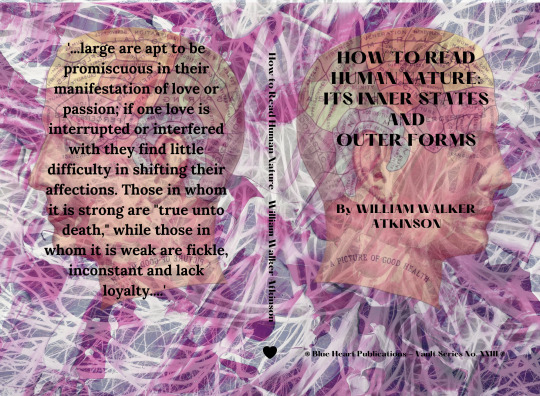
In "How to Read Human Nature: Its Inner States and Outer Forms," William Walker Atkinson embarks on an ambitious journey to unravel the intricate mysteries of the human psyche. Published in the early 20th century, Atkinson's work serves as a fascinating amalgamation of psychology, philosophy, and esoteric wisdom, offering readers a comprehensive guide to understanding both the internal workings and external expressions of human nature. The book's title itself hints at the dual focus—inner states and outer forms—that shapes the foundation of Atkinson's exploration.
Atkinson's prose, though rooted in the language of its time, remains remarkably accessible and engaging. The author's skill in elucidating complex psychological concepts is evident as he delves into the nuances of human behavior, emotions, and thought processes. One of the key strengths of the book lies in Atkinson's ability to bridge the gap between the esoteric and the practical, providing readers with tools to navigate the intricacies of human interactions in their daily lives.
The first part of the book delves into the inner states of human nature, exploring topics such as emotions, desires, and the subconscious mind. Atkinson draws on various psychological theories of his time, blending them with insights from mysticism and metaphysics. His exploration of the impact of thoughts and emotions on one's well-being and interactions reflects a holistic understanding of the human experience.
The second part of the book turns its attention to the outer forms of human nature—physical appearance, body language, and the expressions of personality. Atkinson asserts that external features can offer valuable insights into an individual's character, motivations, and potentialities. While some of the physiognomic theories presented may seem antiquated in the context of contemporary psychology, they offer a glimpse into the historical evolution of ideas surrounding the connection between appearance and character.
Atkinson's work also touches upon the concept of personal magnetism and the power of attraction. He argues that an individual's inner qualities can radiate outward, influencing their external environment and relationships. This exploration aligns with the broader metaphysical currents of the time, emphasizing the interconnectedness of mind, body, and spirit.
Despite the book's age, "How to Read Human Nature" maintains its relevance as a valuable resource for readers interested in the intersections of psychology, philosophy, and spirituality. Atkinson's interdisciplinary approach serves as a bridge between the scientific and the metaphysical, inviting readers to contemplate the intricate dance between internal states and external manifestations in the complex tapestry of human nature.
In conclusion, William Walker Atkinson's "How to Read Human Nature" is a thought-provoking exploration that transcends its historical context. While some aspects may reflect the scientific understanding of its era, the book's enduring value lies in its holistic approach to understanding human nature. It serves as an intriguing testament to the timeless quest to decipher the enigma of the human psyche, offering readers a unique perspective that straddles the realms of science and mysticism.
"How to Read Human Nature: Its Inner States and Outer Forms," by William Walker Atkinson is available in Amazon in paperback 10.99$ and hardcover 18.99$ editions.
Number of pages: 177
Language: English
Rating: 8/10
Link of the book!
Review By: King's Cat
#William Walker Atkinson#How to Read Human Nature#Inner states#Outer forms#20th century psychology#Esoteric wisdom#Comprehensive guide#Dual focus#Human behavior#Emotions#Thought processes#Accessible prose#Psychological concepts#Daily interactions#Subconscious mind#Mysticism#Metaphysics#Holistic understanding#Physiognomic theories#Personal magnetism#Power of attraction#Inner qualities#External environment#Relationships#Interdisciplinary approach#Science and mysticism#Spiritual exploration#Historical context#Thought-provoking#Deciphering human psyche
2 notes
·
View notes
Text
I keep getting stuck in a feedback loop.
"Should I post this thing" "it'll look like you're asking for attention"
But why do I keep worrying about it. Like. Really.
If it really annoys anyone that's following me the unfollow button is right there. I don't need to know about it. I probably don't really know who has unfollowed anyway - it hasn't really BOTHERED me.
So why is it now?
Because I'm screaming into the void. And somewhere along the way I started to forget that. Worrying about annoying the void? The inanimate intangible thing that doesn't even exist?
Maybe it'll annoy some people. I guess that's just how the cookie crumbles. But maybe it's time to stop walking in circles. "Don't post that because it'll be annoying" "don't post that it'll look like you're fishing for comments". Maybe. Maybe not. I need to get back to that space where I'm screaming at the void for me. Not for anyone else to overhear.
Like when I screamed work-in-progress shots to try and convince myself I was making progress. I didn't care about whether people commented, they weren't there for that. It was for me to measure my progress after a certain amount of time and that was it, end of story. If people commented it was a bonus.
So maybe that's what I need to work back towards.
Screaming at the void. And maybe smiling a little inside if it decides to talk back.
1 note
·
View note
Text


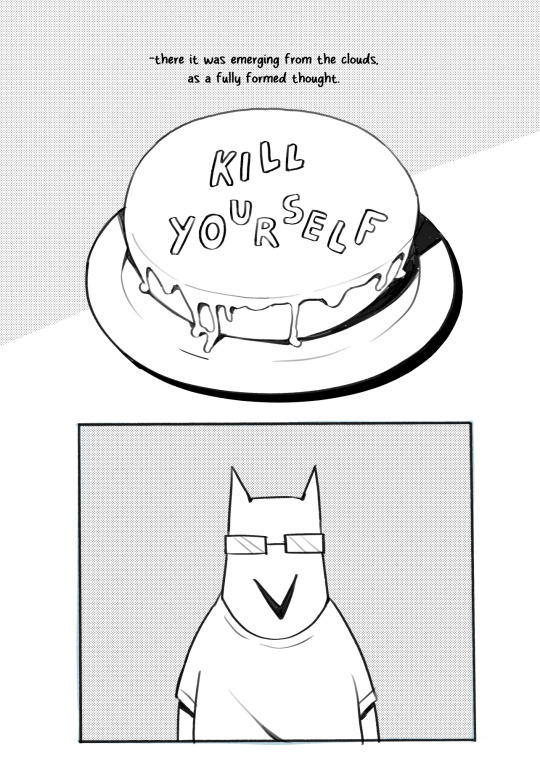
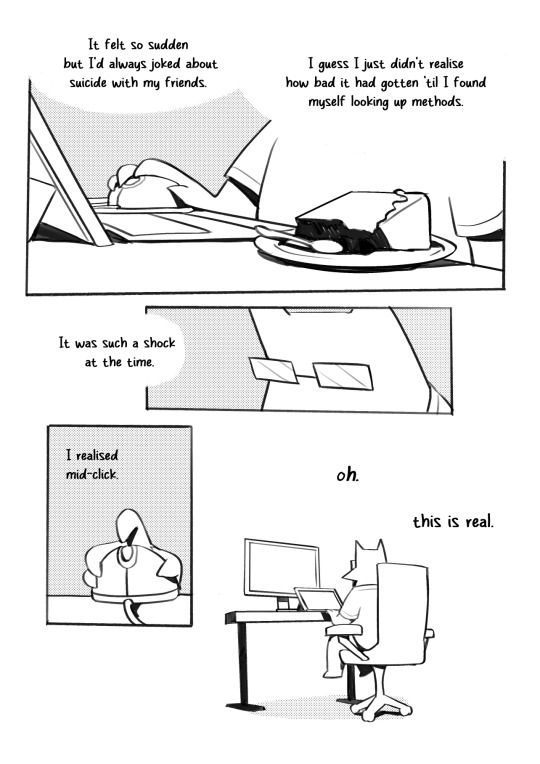
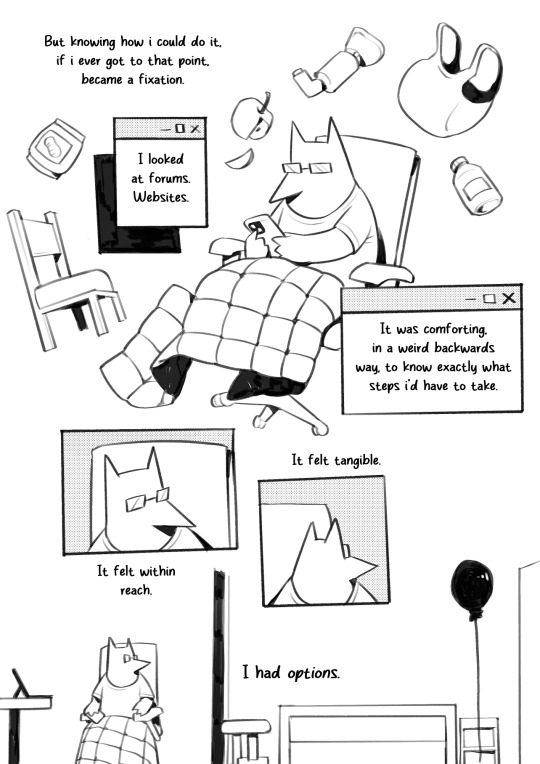
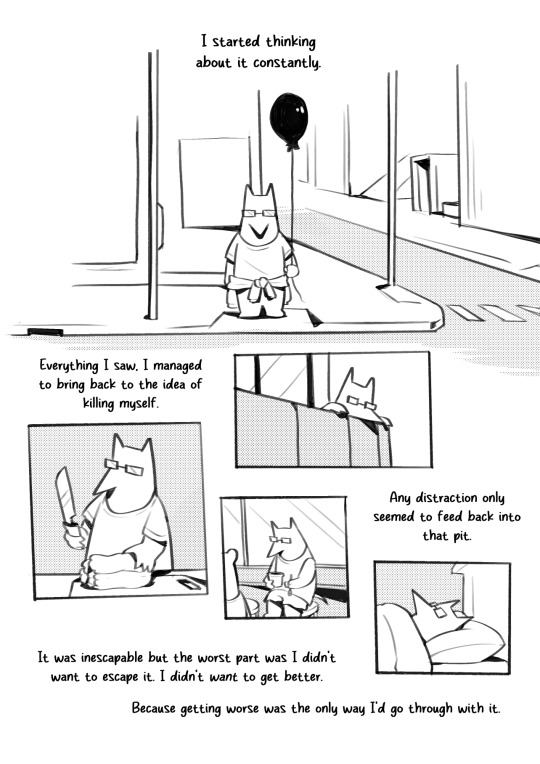
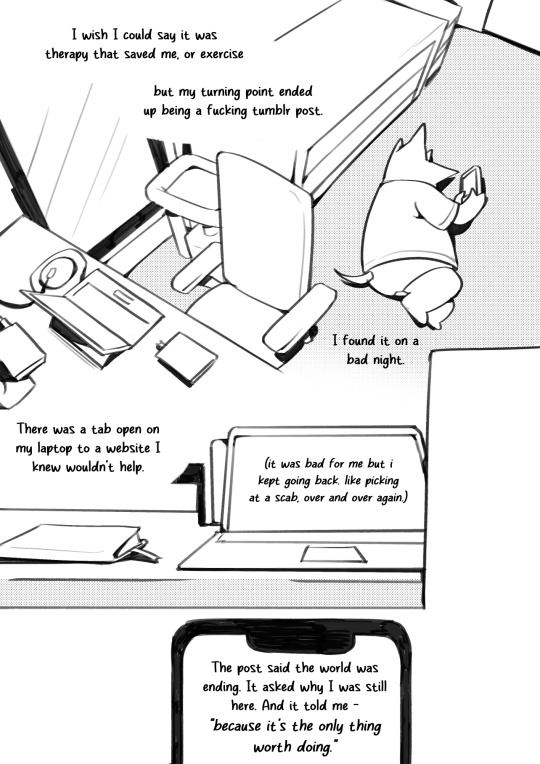


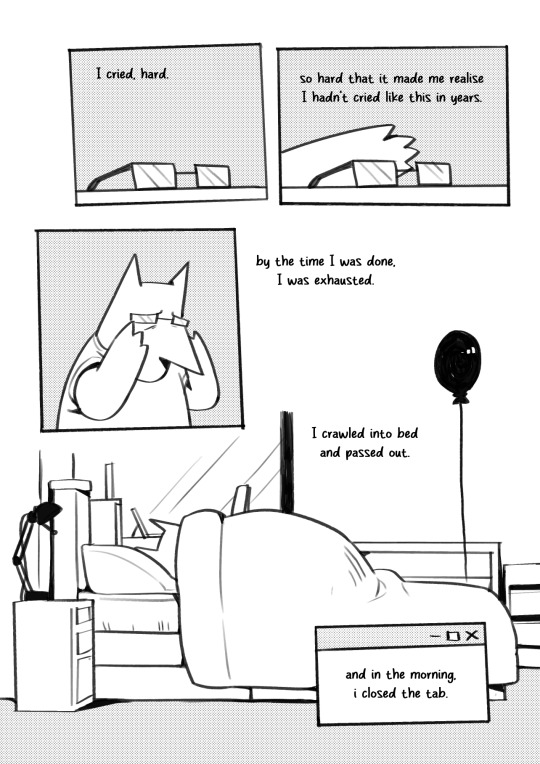
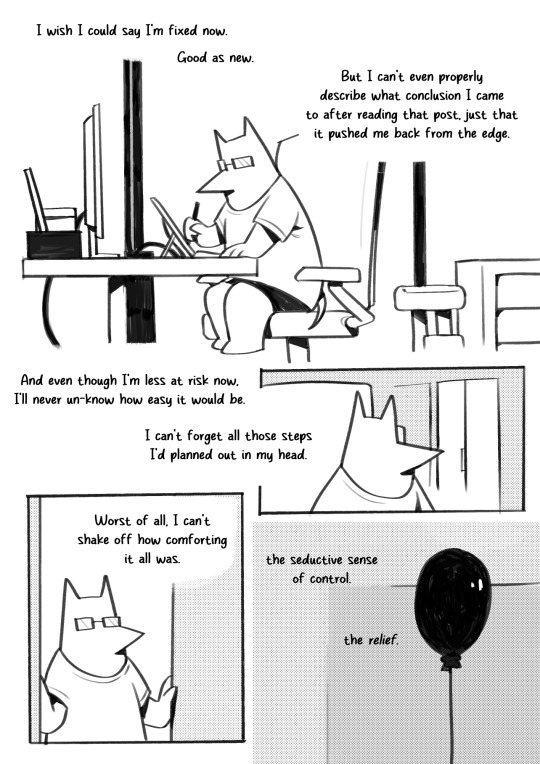

lead balloon (the tumblr post that saved me)
if this comic resonated with you, it would mean the world to me if you donated to this palestinian family's escape fund.
--
no creative notes because this isn't that kind of comic.
I know I don’t owe any of you anything but I still felt compelled to write about my long term absence. And I feel far enough away from the dangerous spot I was in to be able to make this comic. I have a therapist now, and she agreed that making this could be a very cathartic gesture, and the start of properly leaving these thoughts behind me. I am still, at seemingly random times, blindsided by fleeting desires to kill myself. They’re always passing urges, but it’s disarming, and uncomfortable. I worry sometimes that my brain’s spent so long thinking only about suicide that it’s forgotten how to think about anything else. Like, now that I've opened that door for myself, I'll never be able to fully shut it again. But I’m trying my best to encourage my mind in other directions. We'll see how that goes.
I am still donating all proceeds from my store to Palestinian causes. So far, I've donated over $15K, not including donations coming from my own pocket or the fundraising streams which jointly raised around $10K. In the time since I made my initial post about where this money would be going, the focus has shifted from aid organisations to directly donating to escape funds.
If you'd like to do the same, you can look at Operation Olive Branch, which hosts hundreds of Palestinian escape funds or donate to Safebow, which has helped facilitate the safe crossing and securing of important medical procedures for over 150 at-risk palestinians since the beginning of the genocide.
#cw: suicidal ideation#cw: suicide#cw: self harm#cw: mental health#cw: depression#i made the balloon the main representation of my self destructive urges for a reason but im not going to explain it#i tried to keep a lot of the details in this vague#it would be my worst nightmare if this comic encouraged someone to hurt themselves#so. please dont#for a long time even the thought of making this comic felt so insipid and narcissistic#with the state of the world as it is#having the only threat to your life be yourself felt so privileged and trite and shameful#but doing this comic made me sit down and process things in full#and im just. very grateful i didn't give in to my thoughts back when i sincerely felt i'd be more useful to the world dead#i also feel the need to say that this wont represent everyone's battle with mental illness. its unfortunately different for all of us#there is no fix-all#and im afraid this might be one of those comics that either resonates a lot or misses the target by a mile#i made it for myself foremost. and now that its done im glad i did it#thank you for reading#and please stay alive#stillindigo art#stillindigo comics
25K notes
·
View notes
Text
I always pictured Athena watching the events of The Odyssey as they happened to keep tabs on what her ex is doing but it's much funnier to know that she left him on read for 10 years and then came back to a text thread so insane that she immediately had to go fight her dad.
#epic the musical#the wisdom saga#epic the wisdom saga#athena#she just had to process that all in one go huh#i guess that's what quick thought powers are for
8K notes
·
View notes
Text
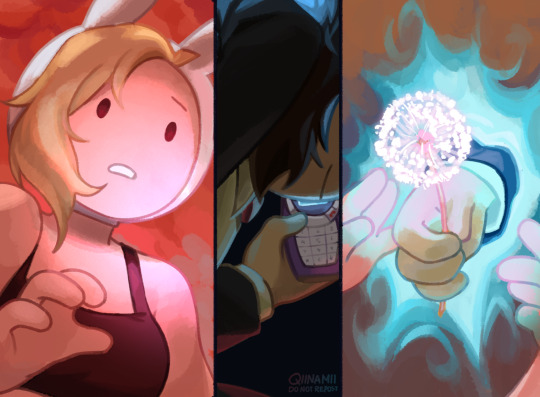
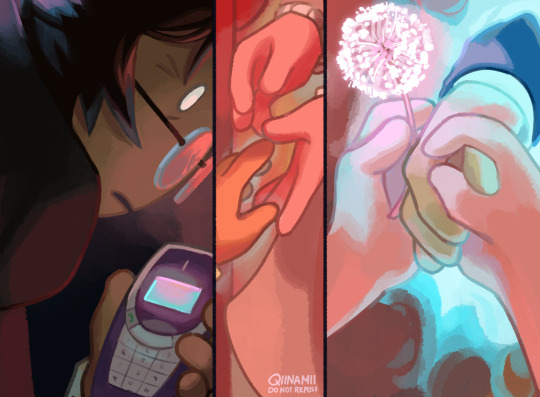

we'll do fine.
#fionna and cake spoilers#what hits me a little is how similar fionna and simon's stories are in the case of finding nuance in their lives#when both have gone through their separate but still valid pain no matter the extent it had been#and its that they met each other they get to see how it compares and they're no less worth of the peace and fun they dreamed of#even in the form of simplicity and just being normal#“i wouldn't have met THE fionna and cake” “we wouldn't have met THE simon petrikov”#it hits me harder that after the dandelion scene would've been their last time seeing each other physically#and how assuring simon sounded when fionna didn't know what to do with the literal world in her hands#tho im sure prismo isnt that much of a rule jerk lol i still drew out the revelation anyway with this tiniest addition#also the fact fionna's world is influenced by simon's thought processes and conditions so now things are a little better for both of them#fionna the human#fionna campbell#simon petrikov#qiiarts#the lil flashback of#betty grof#fionna and cake#adventure time
36K notes
·
View notes
Text
Attitude
Another new day stretches out before us waiting to see how we will use the time given. Before us stretches two paths, one a path of understanding, laughter, strength.. the other one of dark depression, complaints, worry- which path will you choose? We may have no control over all of our circumstances, but we have full control over our attitude. Life is not easy. In the past, during moments of…
View On WordPress
0 notes
Text
Some idle speculation about moopsies.
The traits that humans (and presumably humanoid Star Trek aliens) find cute are those associated with infants - small size, stubby limbs, disproportionately large eyes and heads, behaviour that signals a need for protection and nurturing. (Which is the general response individual people have to things they find cute, whether that actually includes babies for them personally or not.) This is broadly true across social mammals, whereas the offspring of species that provide for themselves from birth without a need for a parental bond often lack these traits if they get in the way of how they feed themselves.
Hypothesis 1: Moopsies evolved to invoke this response to attract or distract prey. Kind of boring, but the most obvious explanation. (I'm not sure how viable that is, though - most advantages of looking cute seem to appear on a longer time span, and encouraging their prey to spend a lot of time close to them doesn't seem very relevant to moopsies' apparent strategy as persistence hunters. Maybe they grow up as brood parasites before they become apex predators?)
Hypothesis 2: Moopsies' appearance is a coincidental product of unrelated selection pressures in their native ecosystem - which is full of species (possibly swamp gobblers, for example) whose infants don't look remotely cute by human standards.
Corollary to hypothesis 2: Swamp gobblers react to human babies the same way humans do to the face of a snarling jaguar.
11 notes
·
View notes
Text

source
#saw those pictures and immediately thought about my writing process#have a shitte meme i guess#writing#fanfiction#ben affleck#5k#8k#20k
20K notes
·
View notes
Text
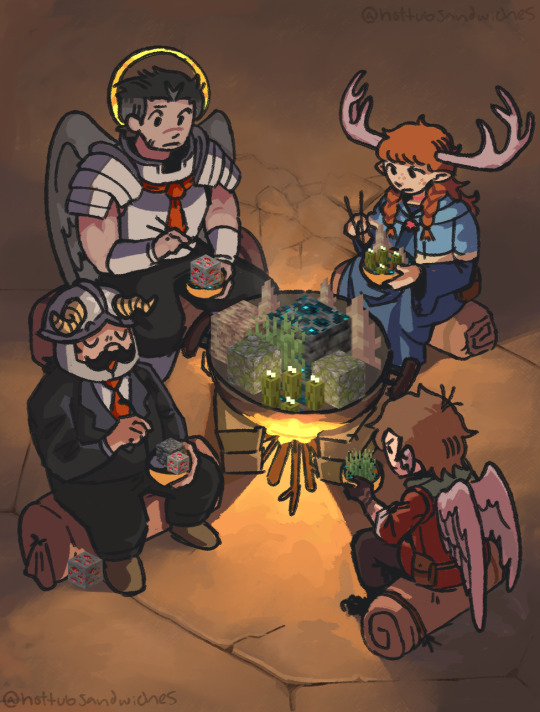
guys is this something
#my thought process:#weird food > delicious in dungeon#mcyt#life series#wildlife#grian#grian fanart#grianmc#skizzleman#skizz fanart#mumbo#mumbo fanart#geminitay#gemcyt#sub one club#spanners#wild life spoilers#i think this came out nice :) i need to finish watching delicious in dungeon now#my art <3
6K notes
·
View notes
Text
Unlocking the Mind's Full Potential
A Journey Beyond the OrdinaryIn a world where our thoughts often run on autopilot, dictated by routine and societal norms, the true potential of the human mind remains largely untapped. It’s akin to a vast, unexplored landscape, brimming with possibilities that transcend the mundane. But how do we navigate this inner wilderness and fully express the capabilities of our minds?The first step is…
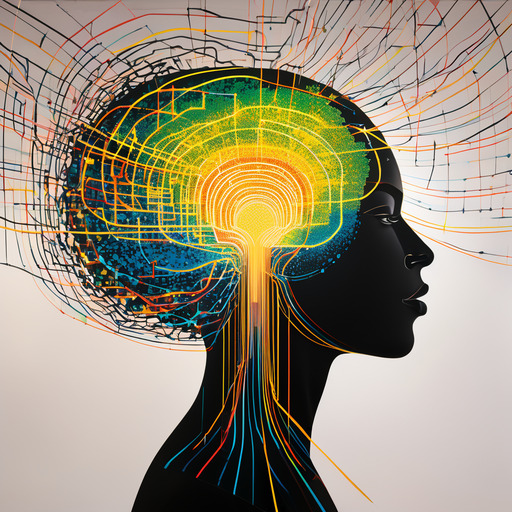
View On WordPress
#Cognitive Development#creativity#Curiosity#Human Potential#innovation#Intellectual Curiosity#mental exploration#mindfulness#Personal Growth#Thought Processes
1 note
·
View note
Text

in spite of everything, I had fun <3
#my art#jujutsu kaisen#jjk#jjk fanart#jjk spoilers#jjk manga spoilers#jjk leaks#yuji itadori#fushiguro megumi#nobara kugisaki#itafushikugi#jjk 271#well we made it :'>#im kind of ignoring a lot of the tag rn ghsdff ik people are upset#if u follow me u know th full extent of my thoughts on the wrapping up of the series but tl;dr the caption says it all#this series meant a lot to me and im working on a bigger tribute to fully express that love and gratitude#but take a redraw 2 tide u over for now#im just so happy. its bittersweet but those r my kids n theyre tgt and theyre okay#i think the return to normalcy is good fr them. i say let them rest n b together n process everything in time#/i'm/ satisfied with what i got out of jjk as a whole and that's all that matters to me#however ik that not everyone shares tht sentiment n thats valid!#regardless of how u feel abt the finale i hope that u at least take time to remember things abt the series that brought u joy#thats all i can say#oh yeah anyway i lightened up megumi's expression his face is so funny in that panel i can't believe he really said -_- until the very end#still tho i think megu deserves a content lil smile
5K notes
·
View notes
Text
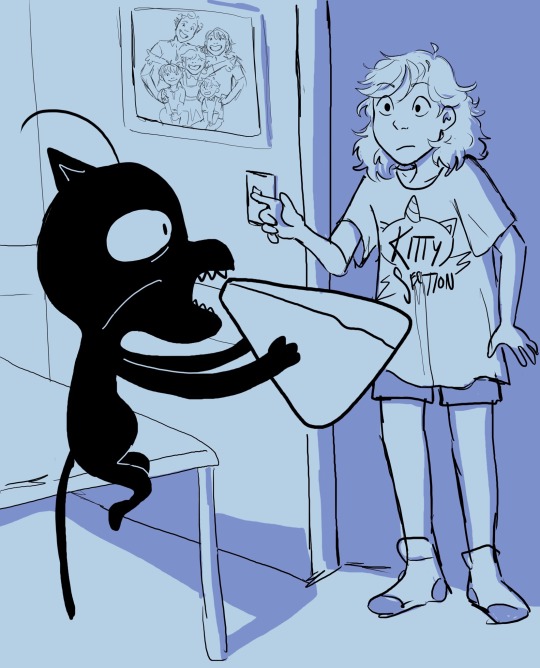
emma dupain cheng on the brain😽🎀
more:
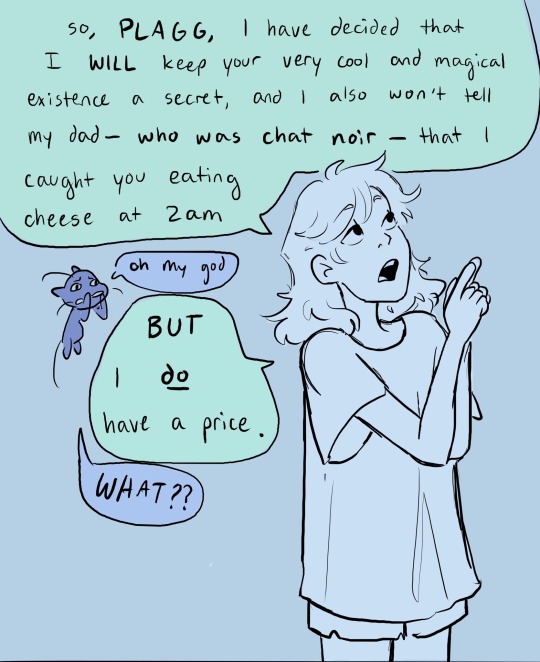

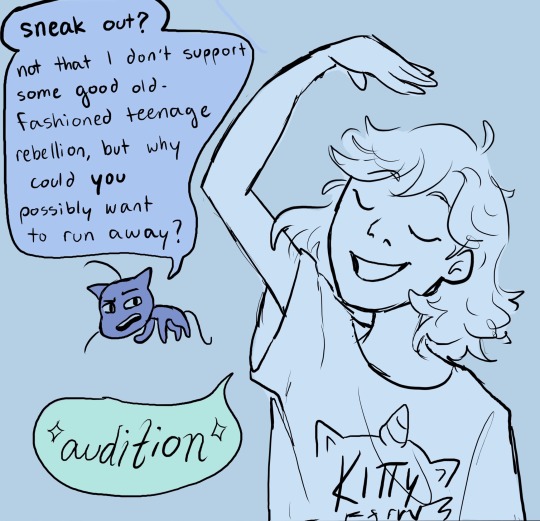
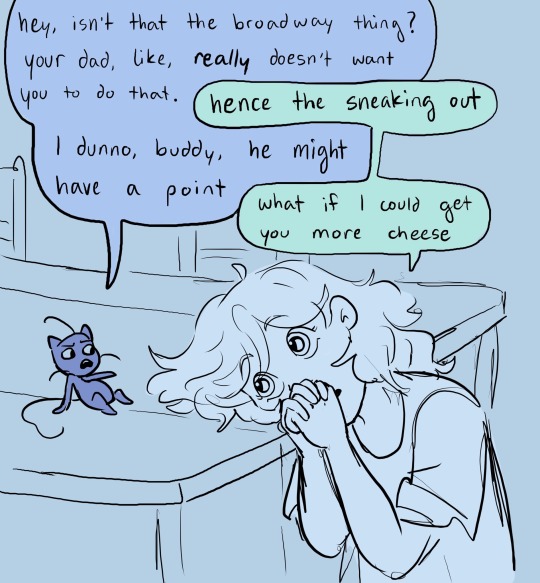
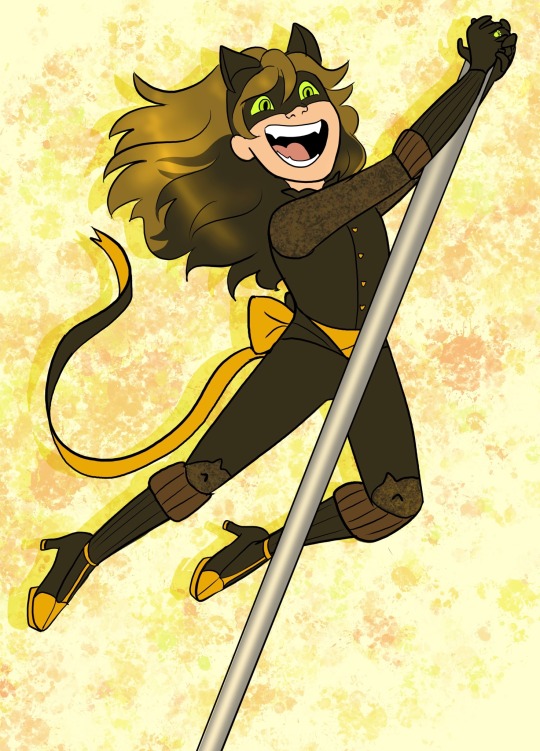
#ml#miraculous#miraculous ladybug#my art#emma dupain cheng#emma agreste#(i think that may the more popular tag for her lol. she is a dupain cheng in my heart though)#plagg#she is thirteen almost fourteen here btw. because i love circularity#emma dupain cheng to me is like. what if emilie or adrien grew up in a stable home with no trauma. that’s emma#and she is theater kid✨#and adrien and marinette are soooo so so supportive and love going to her shows and are so proud of her#/marinette has to be held back from trying to manipulate the school play casting process to secure emma the lead every year#but then emma sets her sights on bigger things(broadway west end)#and adrien pumps the breaks big time#and he’s so torn between supporting her interests and wanting so badly to keep her from like. being a child actor. having a job. b#being pulled from school#and emma gets upset bc he is standing in the way of her dreams#and they fight about it:(#and then emma discovers plagg and convinces him to help her sneak out and go to her callback that she secretly auditioned for#(and forged all the parent signatures for lol)#and. well. plagg CAN be bribed#and also she just reminds him so much of baby adrien🤧 he is a softie#and she runs away to her callback. and adrien and marinette wake up the next morning and see on the news that there is a new chat noir.#anyway. not that i’ve thought about it or anything
5K notes
·
View notes
Text


Dinner at Grian's
#art out the oven#grian#hermitcraft#artists on tumblr#<- this is the most 'artists on tumblr' piece i've made‚ i deserve to tag it /lh#I will reblog this with thoughts and process tomorrow probably. i spent 19 hours on this i'm allowed to ramble a little as a treat <3#edit: made the big image a little better quality hopefully this doesn't take a year to load for people
4K notes
·
View notes
Text
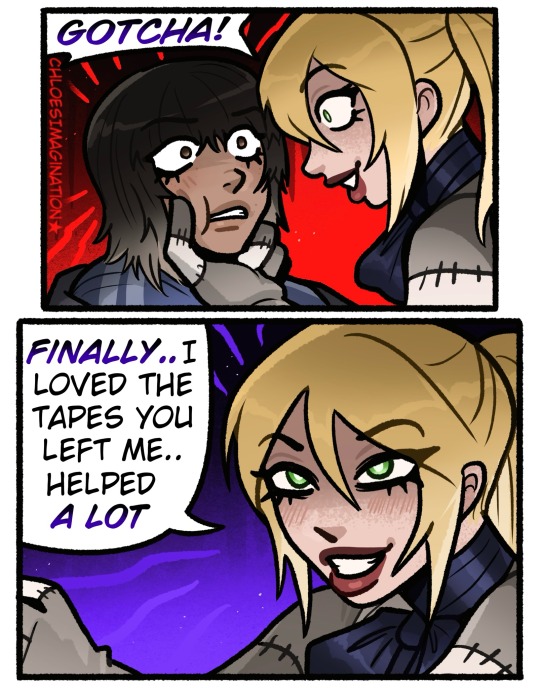
Vanny finally meets FNAF tape girl in person...
#myart#chloesimagination#comic#fnaf#five nights at freddy's#fnaf vanessa#fnaf vanny#tape girl#fnaf tonya#fnaf help wanted#security breach#fnaf fanart#TAPE GIRL MENTIONED AGAIN 🔥🔥#A good handful of folks asks me if I’d draw Tape girl and Vanessa meeting#I THOUGHT it was a fun idea and finally got around to it#my thought process here is Vanny was hunting tape girl down#mean she wants to find the person who gave her this virus after all#just to say thank you I promise :-)#she’s either being genuine or sarcastic when she says it ‘helped her a lot’#probably similar to the Mike deal can’t bring herself to actually harm tape girl#I like the name Tonya for tape girl it’s one of her maybe names and I think it fits#shout out to toxic fnaf yuri…
5K notes
·
View notes
Text
"Decoding the Enigma of Human Nature: William Walker Atkinson's Profound Exploration"
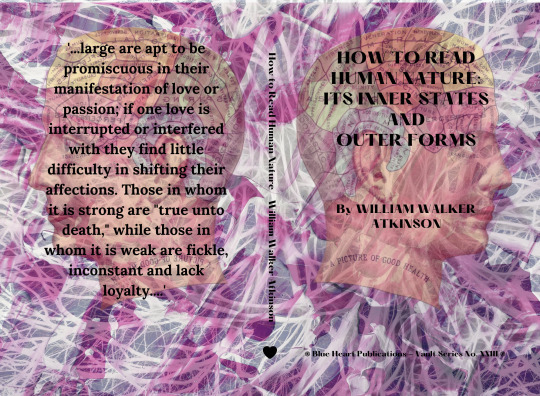
In "How to Read Human Nature: Its Inner States and Outer Forms," William Walker Atkinson embarks on an ambitious journey to unravel the intricate mysteries of the human psyche. Published in the early 20th century, Atkinson's work serves as a fascinating amalgamation of psychology, philosophy, and esoteric wisdom, offering readers a comprehensive guide to understanding both the internal workings and external expressions of human nature. The book's title itself hints at the dual focus—inner states and outer forms—that shapes the foundation of Atkinson's exploration.
Atkinson's prose, though rooted in the language of its time, remains remarkably accessible and engaging. The author's skill in elucidating complex psychological concepts is evident as he delves into the nuances of human behavior, emotions, and thought processes. One of the key strengths of the book lies in Atkinson's ability to bridge the gap between the esoteric and the practical, providing readers with tools to navigate the intricacies of human interactions in their daily lives.
The first part of the book delves into the inner states of human nature, exploring topics such as emotions, desires, and the subconscious mind. Atkinson draws on various psychological theories of his time, blending them with insights from mysticism and metaphysics. His exploration of the impact of thoughts and emotions on one's well-being and interactions reflects a holistic understanding of the human experience.
The second part of the book turns its attention to the outer forms of human nature—physical appearance, body language, and the expressions of personality. Atkinson asserts that external features can offer valuable insights into an individual's character, motivations, and potentialities. While some of the physiognomic theories presented may seem antiquated in the context of contemporary psychology, they offer a glimpse into the historical evolution of ideas surrounding the connection between appearance and character.
Atkinson's work also touches upon the concept of personal magnetism and the power of attraction. He argues that an individual's inner qualities can radiate outward, influencing their external environment and relationships. This exploration aligns with the broader metaphysical currents of the time, emphasizing the interconnectedness of mind, body, and spirit.
Despite the book's age, "How to Read Human Nature" maintains its relevance as a valuable resource for readers interested in the intersections of psychology, philosophy, and spirituality. Atkinson's interdisciplinary approach serves as a bridge between the scientific and the metaphysical, inviting readers to contemplate the intricate dance between internal states and external manifestations in the complex tapestry of human nature.
In conclusion, William Walker Atkinson's "How to Read Human Nature" is a thought-provoking exploration that transcends its historical context. While some aspects may reflect the scientific understanding of its era, the book's enduring value lies in its holistic approach to understanding human nature. It serves as an intriguing testament to the timeless quest to decipher the enigma of the human psyche, offering readers a unique perspective that straddles the realms of science and mysticism.
"How to Read Human Nature: Its Inner States and Outer Forms," by William Walker Atkinson is available in Amazon in paperback 10.99$ and hardcover 18.99$ editions.
Number of pages: 177
Language: English
Rating: 8/10
Link of the book!
Review By: King's Cat
#William Walker Atkinson#How to Read Human Nature#Inner states#Outer forms#20th century psychology#Esoteric wisdom#Comprehensive guide#Dual focus#Human behavior#Emotions#Thought processes#Accessible prose#Psychological concepts#Daily interactions#Subconscious mind#Mysticism#Metaphysics#Holistic understanding#Physiognomic theories#Personal magnetism#Power of attraction#Inner qualities#External environment#Relationships#Interdisciplinary approach#Science and mysticism#Spiritual exploration#Historical context#Thought-provoking#Deciphering human psyche
0 notes